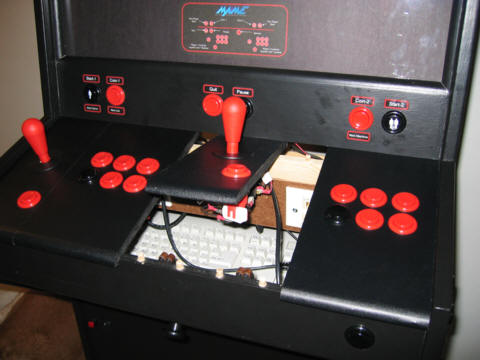Perhaps the most challenging part of the whole project was to come up with some way to securely mount the panels WITHOUT needing tools or much time. Amodular panel would not be of much use if it took me 10 minutes to reconfigure it. The idea was to be able to swap a panel in less than a minute without using tools. In the final design you can reconfigure a single panel in about 20 seconds and swap all the panels in just over a minute. This is really the heart of making a modular panel work - you need to be able to change the panels quickly but still secure them for gameplay.
"Looks" were a design factor as well. While you can't do anything about the small lines between panels, I wanted to avoid any visible connectors, screws and latches on the top of the panel. Ideally the lines of the original panel would be preserved.
I toyed with several designs and made several trips to the hardware store to look at different types of fasteners, rails, etc. Space was a major consideration as my existing open space was only about 9-3/4" by 24". Metal panels, and rails were considered but discarded that in favor of something made of wood that one could easily build in the garage.
Here's the final design - it is the only design that used no tools, could easily snap in and out and could be made in the garage with limited tools. A tabletop drill press was required to complete the drilling accurately.
The mounting system consists of two rails and a reinforced monitor bezel. The front edging of the control panel acts as the front mounting rail. Each rail has dowels installed at 2" intervals along the length. These dowels insert into precisely drilled holes in the bottom of each panel, but the dowels are glued into mounting rails and not the panels.
To insert a panel, you lift the front edge to insert it under the bezel, align the holes on the bottom of the panel with the dowels on the rear rail and then press down on the front of the panel. The panel rotates in place over the rear dowels and snaps down over the front dowel rail.
Empty dowel rails - with dowels installed at 2" intervals. The dowels match holes carefully drilled in the bottom of each panel. You can see that the front of the control panel acts as the forward dowel rail, and the rear dowel rail is spaced just under an inch from the monitor bezel to provide room to insert the edge of the panels under the bezel. The CAT5 patch panels, keyboard, and USB hub are also visible - see the wiring section for more information on that. |
|
The advantage of this system is that a panel locked in place has only one degree of freedom. The bezel is mounted so it is flush with the panel once locked down, and the bezel prevents side-to-side rocking. The dowels prevent movement to either side as well. The only way to unlock the panel is to lift up vertically on the forward edge.
 | Here a joystick panel is propped up on the rear dowels. The picture illustrates how the panels are inserted. You insert the panel under the monitor bezel, align the dowels in the rear rail with the holes in the bottom of the panel and then rotate the front of the panel down to lock it on the front rail. You can also see two roller cabinet locks on the inside of the front rail. These are used only to hold joystick panels down - the joystick just snaps into place and can be unlocked by just lifting from the front edge. |
The only panels that require additional securing are the joystick panels, because none of the other panels (trackball, spinner, buttons) are normally lifted up in any way during play. To secure the joystick panels I used "roller" type cabinet locks on the inside of the front rail. These provide a moderate amount of resistance, but it can easily be overcome when swapping panels by just pressing firmly up on the front edge of the panel. However, they do provide sufficient resistance for gameplay because the short 3-4" arm of the joystick pressed forward does not generate sufficient moment on the 11" panel. It also helps that the control panels are tilted about 12 degrees, again damping any forward moment. To break the latch seal during gameplay one would have to pull the joystick vertically towards your nose (not a normal movement direction) very hard.
The "self-locking" panel system that slides under the bezel and over two dowel rails is really the key to making this modular panel work. Without it you would have to resort to screws, latches or some other kind of system that would require tools and substantially more time to swap the panels.
In this system, you just pop the front of the panel loose by pushing up from the bottom of the forward edge, rotate the panel up and out and then insert a new one in by aligning the holes and then rotating the forward edge down. A single panel can easily be changed in less than 30 seconds with no tools. The analog panels are all USB, so every panel is hot-swappable - you can change configurations entirely without exiting your front end.